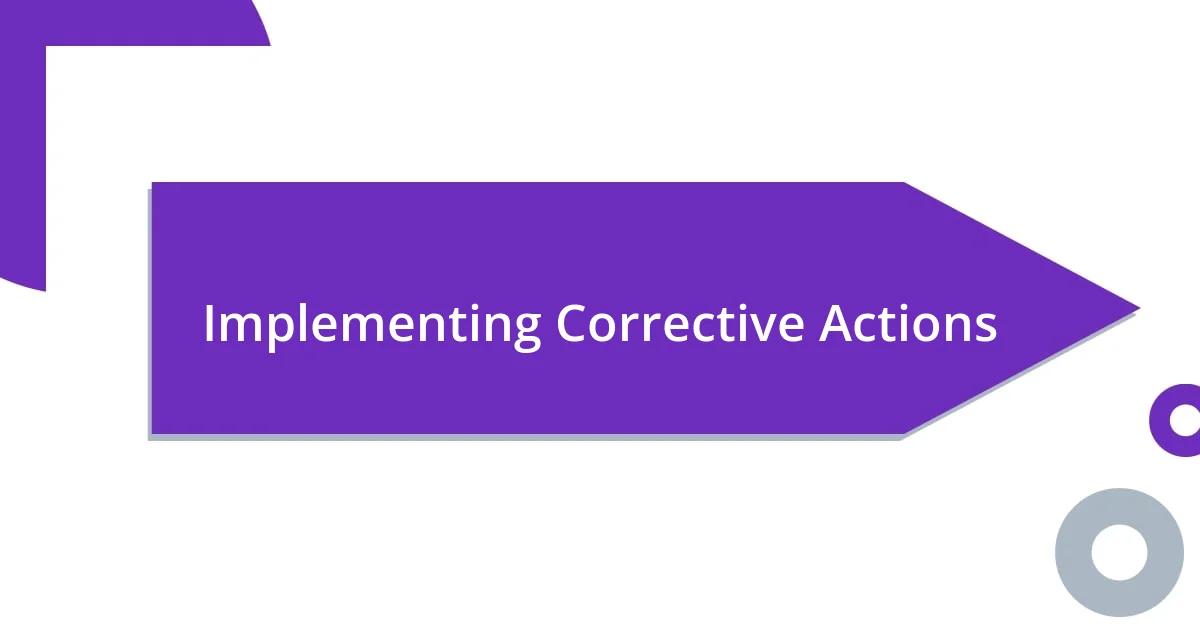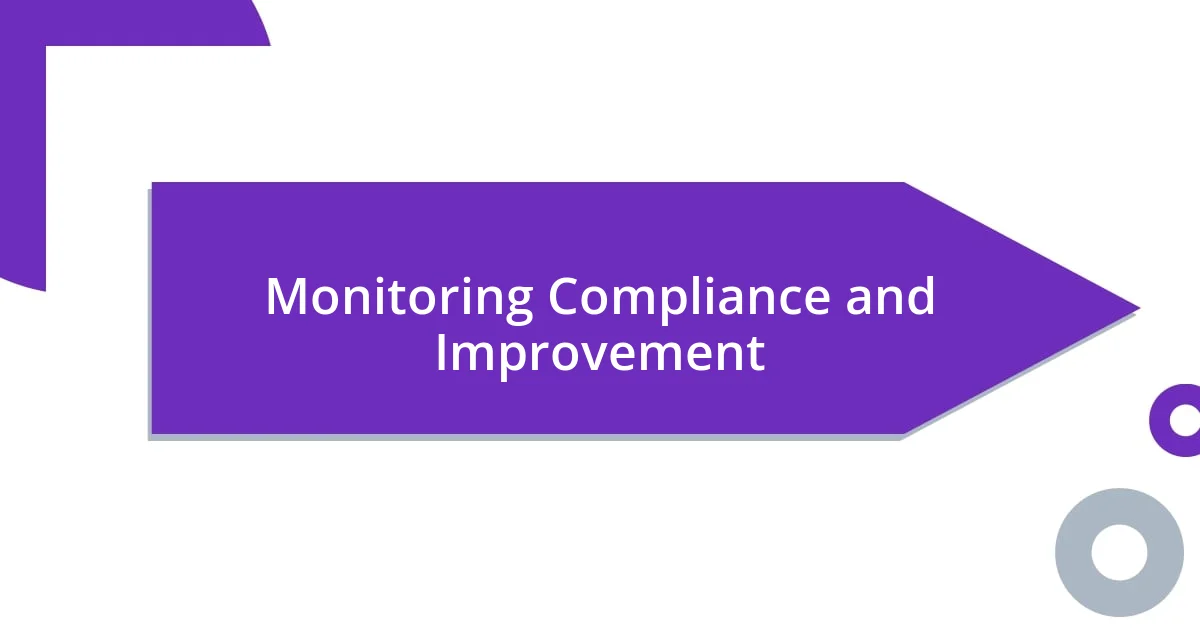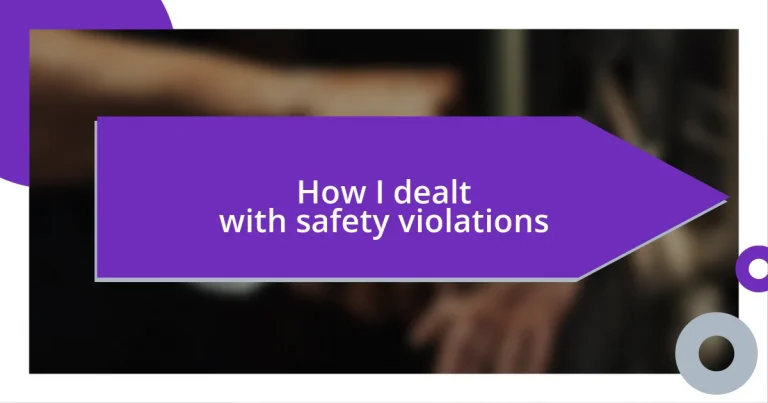Key takeaways:
- Proactive communication with team members can enhance the identification of safety violations and foster a safety-conscious environment.
- Effective documentation of safety incidents, involving team contributions, leads to better accountability and promotes a culture of responsibility.
- Regular reviews and updates of safety procedures encourage team engagement, leading to proactive identification of hazards and a stronger safety culture.

Identifying Safety Violations
When I first began working in safety management, recognizing safety violations felt overwhelming. I often found myself questioning, “Could this seemingly small issue lead to a bigger problem?” This thought process pushed me to pay closer attention to the details, helping me realize that many violations, like cluttered workspaces or improperly stored equipment, stem from complacency rather than intentional negligence.
During a routine inspection once, I stumbled upon a frayed electrical cord that had been camouflaged by the chaos of tools scattered around. The sight sent a chill down my spine—what if someone had tripped and gotten seriously hurt? It was a wake-up call that highlighted the importance of consistent observation and a proactive approach to identifying potential hazards.
I’ve learned that effective communication with team members plays a crucial role in spotting safety violations. I often ask questions like, “Is there anything about your workspace that makes you uncomfortable?” This not only fosters an open dialogue but also empowers others to share their concerns, leading to a more vigilant and safety-conscious environment.

Understanding Regulations and Standards
Understanding regulations and standards is fundamental in safety management. Early in my career, I came across a situation where a lack of knowledge about safety guidelines resulted in near-miss incidents. It struck me that being well-versed in these regulations isn’t just about compliance—it’s about fostering a culture of safety. To put it simply, knowing the rules empowers us to act decisively when violations occur.
Here are some key points to consider:
- Familiarity: Regularly updating myself on OSHA guidelines has been immensely beneficial.
- Clarity: Clear communication of these standards to my team can prevent confusion and ensure everyone is on the same page.
- Training: I realized that conducting training sessions isn’t just a box to check; it’s a chance to engage with the team and reinforce these critical standards.
- Documentation: Keeping accurate records of safety meetings and incidents has been crucial for understanding patterns in violations.
- Feedback: I encourage my team to voice their understanding of these regulations, which often reveals gaps in knowledge we can address together.
Overall, I’ve found that when everyone understands the regulations, it helps create a safer work environment and fosters accountability amongst team members.

Documenting Safety Incidents Effectively
When documenting safety incidents, precision and clarity are key. I recall a time when I hastily filled out an incident report after a slip-and-fall accident. In my rush, I omitted essential details, which later created confusion during the investigation. Taking the time to meticulously note conditions, location, and even weather factors can paint a clearer picture and ensure accountability. This experience taught me that a well-documented incident report can be a pivotal reference in future audits.
Engaging team members in the documentation process not only promotes ownership but also enhances accuracy. I remember a colleague who encouraged fellow team members to contribute their observations after a near-miss incident involving a heavy machinery operation. The insights from various perspectives helped uncover underlying issues that I wouldn’t have noticed alone. This collective effort not only ensured thorough documentation but also fostered a deeper sense of responsibility across the team.
Effective documentation involves more than just filling out forms—it’s about creating a narrative that highlights both the incident and its context. For instance, recording what happened before, during, and after an incident can provide invaluable lessons. I’ve often found that reflecting on these narratives during safety meetings not only reinforces learning but also transforms incidents into opportunities for improvement and growth.
| Documentation Aspect | Importance |
|---|---|
| Detail Orientation | Ensures accuracy and clear understanding |
| Team Involvement | Promotes ownership and diverse insights |
| Narrative Context | Highlights lessons learned for future prevention |

Communicating with Stakeholders
Communicating with stakeholders effectively is vital in addressing safety violations. Early in my tenure, I found myself in a precarious situation where information about a near-critical incident was not effectively shared with management. I realized then that open lines of communication build trust; when stakeholders feel informed, they are more likely to cooperate in finding solutions. Isn’t it powerful when everyone feels like they’re part of the same team?
During those challenging times, I learned the importance of tailoring my message to different audiences. For example, while technical jargon might resonate with the safety team, upper management often needs a broader overview. I once spent a late afternoon preparing a presentation for executives, ensuring it was concise yet impactful. The feedback I received reinforced my belief that conveying information in a relatable manner can energize stakeholders to take meaningful action.
Building rapport with stakeholders is just as important as the information being conveyed. I remember discussing safety protocols with a contractor who seemed resistant at first. However, after genuinely listening to his concerns, I was able to collaborate on a solution. It’s amazing how empathy in communication can turn a potentially contentious interaction into a partnership. Engaging stakeholders is not just about disseminating information; it’s about connecting personally to foster a collaborative approach to safety.

Implementing Corrective Actions
Implementing corrective actions after safety violations is critical for fostering a safe workplace. I remember a time when a minor equipment malfunction led to a near-miss incident. It was a wake-up call that highlighted how we had neglected routine maintenance checks. I took the initiative to develop a preventive maintenance schedule, and it was rewarding to see how this simple step significantly reduced incidents.
Involving the team in corrective actions can transform a bottom-up approach into a shared responsibility. I once facilitated a brainstorming session where team members could suggest solutions for the safety issue we had encountered. To my surprise, the suggestions were rich and diverse, ranging from simple procedural updates to more training sessions. When everyone feels empowered to contribute, it not only improves the quality of actions taken but also boosts morale across the board.
I often reflect on the importance of following up after implementing corrections. For instance, after rolling out a new safety protocol, I made it a point to check in with the team regularly to gauge its effectiveness. It wasn’t just about ticking a box; it turned into an open dialogue about what was working and what wasn’t. Isn’t it fascinating how continuous evaluation can lead to ongoing improvements? Engaging the team in this manner helps solidify the culture of safety and accountability in the workplace.

Monitoring Compliance and Improvement
Monitoring compliance is often a balancing act between oversight and trust. I remember a time when we found ourselves juggling numerous safety regulations, and I opted for a real-time tracking system that updated everyone on compliance status. Watching the team engage with the platform not only streamlined our processes but also reinforced their commitment to safety. It made me wonder—how often do we underestimate the power of transparency in fostering accountability?
Regular audits became an invaluable part of our compliance journey. After grappling with some unexpected violations, I initiated a monthly review process to assess our adherence to safety protocols. It was enlightening to sit down with my team to dissect the data; we quickly acknowledged areas of improvement, and that open forum encouraged honesty. Reflecting on how those sessions transformed our team dynamic has been incredibly rewarding.
To truly drive improvement, I learned that feedback loops are essential. We established a practice where team members could anonymously report concerns or suggest enhancements regarding safety compliance. I vividly recall the sense of relief expressed by one colleague who finally felt heard. Isn’t it fulfilling when you create a safe space for your team to voice their thoughts? This not only strengthens our compliance culture but also drives continuous improvement, making safety a shared priority in our workplace.

Regularly Reviewing Safety Procedures
Regularly reviewing safety procedures has been a game changer for us. I recall a quarterly meeting where we went through our safety protocols with a fine-tooth comb. One suggestion from a newer team member stood out: to incorporate more visuals in our safety signage. Implementing her idea not only made the messages clearer but also fostered a sense of belonging in the workspace. Isn’t it incredible how fresh perspectives can lead to tangible improvements?
As part of our review process, I found that involving everyone in discussions about safety made all the difference. During one session, a team lead shared a story about an incident he narrowly escaped due to outdated procedures. His emotional recounting resonated deeply with the group, reminding everyone that safety isn’t just a checklist—it’s about protecting our lives and well-being. How often do we truly connect safety to our personal experiences in the workplace?
What impressed me most about these reviews was the shift in mindset they sparked. Over time, I noticed a synergy developing; team members started proactively identifying potential hazards before they escalated into issues. One employee even created a safety checklist for her department based on our discussions. It was a small but powerful step that reinforced a culture of vigilance. Don’t you feel a sense of pride when your team takes ownership of their safety? It’s moments like these that make regular reviews essential, fostering ongoing engagement and a proactive approach to safety in all aspects of our work.














